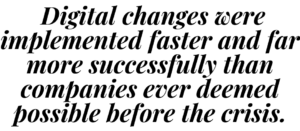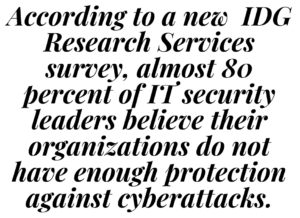The coronavirus has had significant effects on the way we live and work, and some of the adaptations will remain well after the threat of the pandemic diminishes. An October 2020 McKinsey Global Survey of executives indicates that organizations accelerated their digital interactions and operations by at least three to four years in the past year. Development of digital (or digitally enabled) products has accelerated even faster, by an astounding seven years. The changes were implemented faster and far more successfully than companies ever deemed possible before the crisis. Businesses that embraced digital solutions have enjoyed a significant advantage. The ones that were reluctant to embrace digital transformation are finding themselves frantically catching up.
Increasingly respondents expect that these changes will be long-lasting, and companies are investing in their future success. Businesses will need to keep adapting to remain competitive in this new business and economic environment.
The new digital revolution has truly left almost no part of business untouched:
Virtual remote work
More than half of workers are currently doing their job from home, all or most of the time. Respondents to the McKinsey survey claim that their companies moved about 40 times faster than they thought possible before the Covid-19 crisis. Companies implemented solutions in an average of 11 days versus what would have taken more than a year before the pandemic. Digital collaboration has improved dramatically during this time, and workers and companies have new comfort levels with remote work.
The widespread availability of technologies greatly helped the transition and facilitated collaboration and communication, such as Zoom, Slack, Google Hangouts, and others. These platforms enabled people to adapt to a remote office somewhat seamlessly. Not without challenges, of course. Zoom, for example, saw its users increase from 10 to 300 million in just four months. However, they responded at record speed, opening new data centers and signing partnerships with strategic partners to allow for the quick expansion.
Digital customer interaction
This past year has changed how customers engage with businesses, and companies had to respond quickly. Customer interaction digitization accelerated by three years on average, and 2020 saw many digital customer interaction records: the highest number of consumers that made an online bill payment (32%), the highest number of consumers that used the chat feature on a website or app (19% overall).
There was also a significant increase in the use of mobile options (49%). Most customers now prefer to receive statements and essential documents directly into their cloud storage (58%). An example of one company that had to adapt quickly to the digital revolution was Thor Industries. Thor Industries’ RV customers have historically been predominantly older and a group that preferred in-person sales. Last year changed everything. Covid-19 safety concerns made RV travel appealing to Gen X, Gen Z, and Millenials, a customer that prefers online interaction. Thor Industries almost entirely eliminated their traditional sales channels in favor of digital sales and were able to capture this new market segment.
Now, this digital revolution doesn’t mean that customers are entirely turning away from printed communications. Customers expect an omnichannel experience, and standards for relevant content and ease of personalized digital interactions were raised dramatically during this time. Forty-three percent of consumers turned away from businesses that failed to personalize the interaction adequately. That number was highest among Millenials and GenXers.
Clearly, it will be crucial for companies to continue to develop seamless print and digital interactions that connect to individual customer preferences. To be able to do that, they have to understand their customer. Hershey’s has that advantage. This past year, they saw a tremendous increase in demand for their 6-pack milk chocolate bars last summer as people were meeting outdoors and making s’mores on BBQs. Because Hershey’s already had extensive consumer data analytics in place, they noticed this trend right away. Their sales team understood exactly where sales were booming and were able to capture the growth.
Digital business offerings and platforms
Digital business uses technology to create new products, new business models, and new operating systems. The most significant leap this past year has been in the share of these digital offerings. In the past, companies have been careful about introducing new technology, fearing that customers needed time to adapt. The pandemic has primarily erased this resistance and expedited the digital transformation by an average of 7 years. Seven out of ten Gartner board directors now say they want to accelerate digital business and view it as a tool to help companies move forward during this period.
Among the many industries that have benefitted from this digital transformation are healthcare, financial and professional services, and e-commerce. Unfortunately, many also lost customers because of this trend. The pandemic saw a record number of banking customers moving to competitors. Between 25-51 percent of customers turned to banks that were not their primary provider for more affordable products and better digital tools. Unfortunately, the types of products (loans, credit cards, and investments) they sought were high margin products, and the defections significantly damaged the primary banks’ bottom line.
Where is all of this leading? Well, by 2026, almost 26% of the world’s GDP is expected to be based on internet-based and digitally connected industries. There is often a dark side to progress, though, and the digital economy boom is no different. A small number of countries (USA, China, Japan, and EU) and a relatively small number of firms (Amazon, Apple, Facebook, Microsoft, and such) are reaping the majority of dividends of this changing economy.
Cybersecurity
Besides inequality issues, there are also detrimental environmental impacts, and cybercrime has seen an unprecedented boom. The FBI has seen an unsettling increase in cybersecurity complaints since the beginning of the pandemic. Global losses from cybercrime passed $1 trillion in 2020. Dorit Dor, VP of products, Check Point Software, says: “Businesses globally surprised themselves with the speed of their digital initiatives in 2020: it’s estimated that digital transformation was advanced by up to seven years. But at the same time, threat actors and cybercriminals also changed their tactics so that they could take advantage of these changes, and the pandemic’s disruption, with surges in attacks across all sectors.”
Security Magazine describes the most damaging threats for 2021:
- Social Engineering: Almost a third of the breaches incorporated social engineering techniques. 90% were phishing.
- Ransomware: Ransomware is the third most popular type of malware used in data breaches. The overall sum of ransom demands will have reached $1.4 billion in 2020
- DDoS attacks: Hackers employ devices previously compromised by malware or hacking to form a botnet needed for a coordinated DDoS attack. There were 4.83 million DDoS attacks attempted in the first half of 2020 alone, and each hour of service disruption may have cost businesses as much as $100k on average.
- According to Verizon, third-party web applications were involved in 43% of the breaches, and as much as 80% of organizations experienced a cybersecurity breach originating from a vulnerability through these vendors.
- Cloud computing vulnerabilities: hackers performed 7.5 million external attacks on cloud accounts in Q2 2020.
The consequences are alarming. A recent IBM and Ponemon Institute study found that the average cost of a data breach in 2020 was $3.86 million. The report points out that the primary threat vectors for data breaches are stolen employee credentials and misconfigured cloud services. As employees worked remotely and required more access to cloud services to perform their duties, both of these threat vectors contributed to increased incidents. The Federal Trade Commission reported that the number of identity theft cases in the United States doubled in 2020 from the year before. It received 1.4 million reports of identity theft last year. Cybersecurity Ventures expects global cybercrime will cost the world $10.5 trillion annually by 2025.
Still, according to a new IDG Research Services survey, almost 80 percent of IT security leaders believe their organizations do not have enough protection against cyberattacks, even though IT security investments were made in 2020 to deal with the work-from-home challenges.
As businesses become ever more tech and digital-friendly, they must also confront the realities that as criminals lurk in the real world, they are just as present in the virtual world ready to pounce on opportunities.
The bottom-line message: The world is moving online faster than ever. Move swiftly, but with as much research into how to protect what you build and offer as possible.
Featured photo sourced from Pexels which can be found here and secondary photo also sourced from Pexels can be found here.










